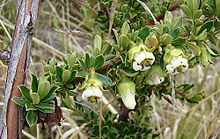| Escallonia myrtilloides | |
|---|---|

| |
| Branchlet with leaves and flowers | |
| Scientific classification | |
| Kingdom: | Plantae |
| Clade: | Tracheophytes |
| Clade: | Angiosperms |
| Clade: | Eudicots |
| Clade: | Asterids |
| Order: | Escalloniales |
| Family: | Escalloniaceae |
| Genus: | Escallonia |
| Species: | E. myrtilloides |
| Binomial name | |
| Escallonia myrtilloides L.f. | |
| Synonyms | |
| |
Escallonia myrtilloides is an evergreen shrub or tree in the Escalloniaceae family, native to open montane wet forests and paramos from Costa Rica to Bolivia. It occurs at elevations between 1,900 and 4,200 metres (6,200 and 13,800 feet).
Description
Trees or shrubs from 2–6 metres (6 ft 7 in – 19 ft 8 in) high, with irregular to conical shaped crown and branches growing almost horizontally, giving the tree the appearance of a Chinese pagoda. Leaves dark green, leathery, obovate, of 0.8–2.3 centimetres (0.31–0.91 in) long, 0.4–1 centimetre (0.16–0.39 in) wide; borne on short twigs. Inflorescences in corymbs of 1–1.5 centimetres (0.39–0.59 in) long; flowers greenish white to pale yellow; fruits green, ca. 0.6 centimetres (0.24 in) wide, with numerous seeds.
Distribution and habitat
The species is found in high Andean wet forests, open areas and paramos, and is often dominant on rocky slopes.
Uses
Escallonia myrtilloides furnishes a reddish wood, with resistance to tension and shocks and easy drying. Because of this, it is useful for fences and woodcrafts.
The tree has an ornamental quality due to its distinctive crown shape, and is also used for hedges.
References
- "Tropicos.org". Missouri Botanical Garden. Retrieved 2 April 2017.
- ^ Gargiullo, Margaret (2008). A field guide to plants of Costa Rica. New York: Oxford University Press. pp. 180. ISBN 978-0-19-518824-0.
- ^ "Escallonia myrtilloides". Biodiversidad de Costa Rica (in Spanish). INBio. Archived from the original on 25 September 2015. Retrieved 23 September 2015.
- ^ "Rodamonte - Escallonia myrtilloides". opepa.org (in Spanish). Organizacion para la Educación y Protección Ambiental. Retrieved 24 September 2015.
- "Ciprecillo". El Mundo Forestal (in Spanish). Archived from the original on 24 June 2014. Retrieved 24 September 2015.
| Taxon identifiers | |
|---|---|
| Escallonia myrtilloides | |